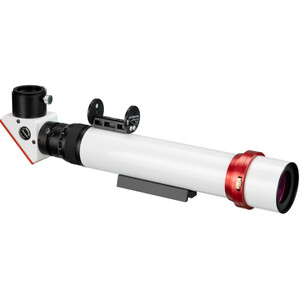The fascination with observing the Sun
Astronomy is not just something we do at night. Observing the Sun can also be a fascinating activity.

Sunspots, flares and prominences - observing the Sun with a telescope
Astronomical observation is not only a nighttime activity, observing the Sun can also become a fascinating hobby. The H-alpha sector in particular is currently experiencing a boom. It’s fantastic that the amateur astronomer now has a wide range of H-alpha telescopes available to choose from.
Observing the Sun in white light
 Group of sunspots / Hans Eggendinger
Group of sunspots / Hans EggendingerWe often look at the stars on clear nights and observe worlds that are many light years away from Earth. But why do we always stray so far from home? One of the most interesting objects in the sky is right here on our doorstep: the Sun.
Our central star offers the amateur astronomer some really fascinating observing opportunities. It is the only star where we can directly observe all the details on its surface. In this respect, there is nothing to equal it in the night sky. When we talk about the Sun's surface, we do not mean a solid surface, of course, but rather a section of its atmosphere, which we can examine when we observe the Sun. This is the Sun’s photosphere.
Solar filters made of glass and foil
Everyone already knows, but still you cannot hear it often enough: never look at the Sun without a suitable solar filter, otherwise your eyes could be irreparably damaged. The best way to observe in white light with a telescope is to use an objective solar filter.
These are available in the form of a foil or a glass filter. The most popular is the coated foil.
However, you will need to construct the filter holder yourself. Glass filters are usually supplied in an aluminium mount and are ready to use. These can therefore be attached directly to a telescope. The optical quality requirements for glass filters are very high. They must be uniformly coated and have exact, plane-parallel surfaces. So-called wedge errors can arise with the more inferior glass filters.
In such cases, there are variations in the glass thickness, and the light rays can be deflected and split. A poor-quality filter would therefore only provide a blurred image of the Sun.
The Sun in H-alpha light...
... reveals a dramatic face. While the structures in white light are stable over a period of a few hours, our Sun shows dramatic changes when observed in the light of the H-alpha spectral line.
Bright flares can form on the surface, which appear and disappear within the space of a few minutes. Dark filaments float above the Sun’s surface, and prominences are visible at the edges. Prominences are gigantic gas eruptions, which are often many times larger than the diameter of the Earth. They arise in a wide variety of shapes and sizes. Some can be a large as half the diameter of the Sun itself.

While such huge eruptions are very rare, smaller prominences are almost always to be seen. Even during periods of minimal sunspot activity, there are usually several visible every day. The prominences are constantly changing, and photography is the best way to demonstrate this. Monochrome cameras, such as The Imaging Source’s DMK, are ideal. But, even with simple webcams, you can achieve really nice results.
Earlier H-alpha filters had an occulting disc that had to be tracked very accurately. With modern filters, the surface and edge can be observed simultaneously. Entry-level systems are now available for less than €1,000.
Astroshop has all the leading manufacturers in its product range, including the industry newcomer Lunt, the Meade subsidiary Coronado, the established producer DayStar, and the high-end manufacturer Solarscope. Report from Bernd Gährken, a member of our team.
Solar telescopes for H-alpha and calcium K light observation

Observing the Sun can be a really fascinating occupation, but it is only in H-alpha light that it reveals an allure that is irresistible. In summer, both before and after work, the Sun is high enough above the horizon for us to be able to resolve fine structures on the surface.
Sunspots are subject to an 11-year cycle. At the moment we are close to the minimum of the solar cycle, so sunspots are rarely seen. However, there are always interesting structures to be observed in the H-alpha line. Even during periods of low activity, the Sun usually reveals some prominences and offers some interesting sights.
For many decades, H-alpha filters were prohibitively expensive for amateurs, costing €10,000 or more. In addition, they had only limited lifespan and required a great deal of maintenance. Coronado’s PST changed everything. For the first time, a viable device was available for less than €1,000.
Besides the three US suppliers Coronado, Daystar and Lunt, Solarscope is also a manufacturer well-known in Europe. Solarscope manufactures its filters only in small quantities, but their quality standards are uncompromisingly high. We offer all four suppliers’ complete ranges in our shop.
Recommended solar telescopes






